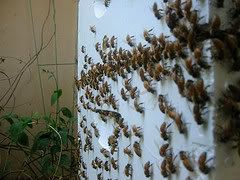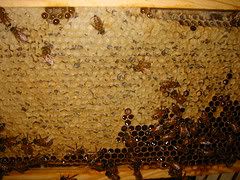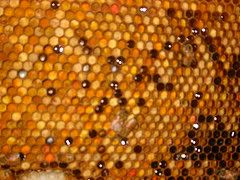Too much POLLEN!
Today I only had enough time to look at the hives on my property so that's the captured hive and the Italian one. The KTBH and the Russian hive will have to wait untill monday. What could possibly have taken all of today's time? BEEKEEPING SEMINAR! Florida State Beekeepers' association meeting where the TBBA meets...you know I won't pass that up. Spent the day learning about varroa and SHB research as well as honey marketing and AHB controls/detection. Anyways, before I bore you to tears, here's the update.
Captured Hive:
Not much change. They've gone up alot in population and now are drawing out the outer two frames. The center three are mostly full of brood and pollen. They have a little honey but, probably a few rainy days and they'll be completely out. The Palmetto is flowing and that's probably what's keeping them aloft...literally.(for those of you who didn't get that or are already a year into Summer Break...I was refering to the fact that honeybees fly...) They were a little "on edge" but, no stings. I'm almost convinced that they are truely ferral SMR (Surpressed Mite Reproduction). They have been removing pupae and I can see that the pupae they're carrying out all have at least 1 mite on it.
Italian Hive:
Before I opened the hive I thought I'd take some pictures of the outside for a change.

Here, they're "washboarding" which is when they crawl around the outside of the hive and appear to do "the WAVE". They use thier tounges and front legs to remove bacteria and dirt which contaminate the outside of their hives. They're hygenic little insects aren't they.

In the top super of the hive I have frames of honey which look like this. The white portion is the capped honey, ready for human consumption. A frame like this is perfectly ready for extraction and, each side is about 1 pint of honey.

Here is a frame from a half super of pollen. This is the bees' protein source and, why their storing so much of it...I haven't the slightest clue. Usually, they can use it all up pretty fast and they don't have enough to store. Soon they'll make a thin layer of honey on top of it to preserve it and cover that in a wax capping. This pollen will come in handy next spring!
I continued going through the hive down to the brood nest. The outer frame was nothing but honey and they have all stages of brood present; a perfectly healthy hive. There was also a lot of pollen there too but, that's where the pollen should be anyways. This colony is deffinately very strong and is in perfect shape for me to leave alone for 2 weeks.

This photo just gives you an idea of the population. As you can see, there's plenty of bees. If you look carefully, you can see capped honey, capped brood, open pollen and young, open brood. That last one is a little tricky...
All in all, not much to report. These hives are doing well and it seems like either varroa levels have gone down or, they've just been diluted. I plan to treat these colonies with Apiguard after I extract the honey.
Captured Hive:
Not much change. They've gone up alot in population and now are drawing out the outer two frames. The center three are mostly full of brood and pollen. They have a little honey but, probably a few rainy days and they'll be completely out. The Palmetto is flowing and that's probably what's keeping them aloft...literally.(for those of you who didn't get that or are already a year into Summer Break...I was refering to the fact that honeybees fly...) They were a little "on edge" but, no stings. I'm almost convinced that they are truely ferral SMR (Surpressed Mite Reproduction). They have been removing pupae and I can see that the pupae they're carrying out all have at least 1 mite on it.
Italian Hive:
Before I opened the hive I thought I'd take some pictures of the outside for a change.

Here, they're "washboarding" which is when they crawl around the outside of the hive and appear to do "the WAVE". They use thier tounges and front legs to remove bacteria and dirt which contaminate the outside of their hives. They're hygenic little insects aren't they.

In the top super of the hive I have frames of honey which look like this. The white portion is the capped honey, ready for human consumption. A frame like this is perfectly ready for extraction and, each side is about 1 pint of honey.

Here is a frame from a half super of pollen. This is the bees' protein source and, why their storing so much of it...I haven't the slightest clue. Usually, they can use it all up pretty fast and they don't have enough to store. Soon they'll make a thin layer of honey on top of it to preserve it and cover that in a wax capping. This pollen will come in handy next spring!
I continued going through the hive down to the brood nest. The outer frame was nothing but honey and they have all stages of brood present; a perfectly healthy hive. There was also a lot of pollen there too but, that's where the pollen should be anyways. This colony is deffinately very strong and is in perfect shape for me to leave alone for 2 weeks.

This photo just gives you an idea of the population. As you can see, there's plenty of bees. If you look carefully, you can see capped honey, capped brood, open pollen and young, open brood. That last one is a little tricky...
All in all, not much to report. These hives are doing well and it seems like either varroa levels have gone down or, they've just been diluted. I plan to treat these colonies with Apiguard after I extract the honey.
1 Comments:
These are fantastic pictures...I enjoy your blog and have visited it before. I also love your humor on beemaster. Linda T
(aka tillie, beekeeperlinda)
Post a Comment
<< Home